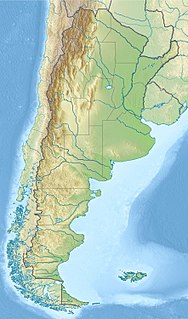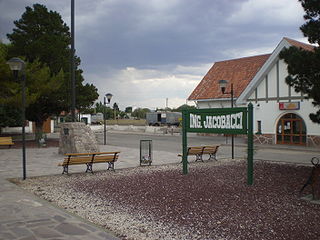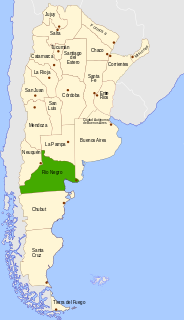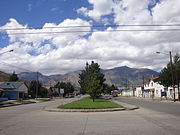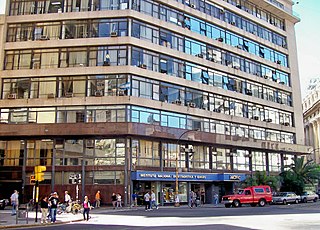
Río Gallegos is the capital and largest settlement of the Patagonian province of Santa Cruz in Argentina. Located in the department of Guer Aike, it has a population of about 98,000, according to the 2010 census [INDEC], a 24% increase from the 79,000 in the 2001 census [INDEC]. The city bears the name of the Gallegos River, and sits on its estuary 2,636 km (1,638 mi) south from the Argentinian federal capital Buenos Aires.

Trelew is a city in the Chubut Province of Argentina. Located in Patagonia, the city is the largest and most populous in the low valley of the Chubut River, with 97,915 inhabitants as of 2010. The Trelew municipality is part of the Rawson Department, whose capital, Rawson, is also the provincial capital.

Río Grande is a city in Argentina, on the north coast of the eastern part of the Isla Grande de Tierra del Fuego. It has a population of 67,038, and is the industrial capital of the Tierra del Fuego Province.

San Luis is the capital city of San Luis Province in the Cuyo region of Argentina. It is also the seat of the Juan Martín de Pueyrredón Department.

Malargüe is a city in the southwest part of province of Mendoza, Argentina, about 370 km south of the provincial capital Mendoza. It is the head town of the Malargüe Department, and it has about 27,000 inhabitants as per the 2010 census [INDEC].

Cerro Catedral is a mountain located 19 kilometres (12 mi) from San Carlos de Bariloche, and inside the Nahuel Huapí National Park, Patagonia, Argentina.

Pehuajó is a city in the Pehuajó Partido in the province of Buenos Aires, Argentina. The partido has about 38,400 inhabitants as per the 2001 census [INDEC]. The name of this relatively small city is well known in Argentina because of María Elena Walsh's song Manuelita, about an adventurous turtle (tortoise); a dilapidated concrete statue of María Elena Walsh's Manuelita lies just outside the city, beside Ruta Nacional 5.
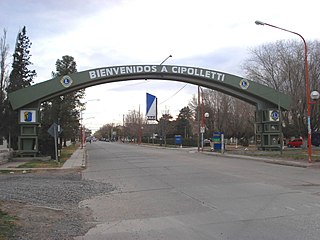
Cipolletti is a city in north of the Patagonian province of Río Negro, Argentina, with 75,078 inhabitants at the 2001 census [INDEC].

Puerto San Julián, also known historically as Port St. Julian, is a natural harbour in Patagonia in the Santa Cruz Province of Argentina located at 49°18′S67°43′W. In the days of sailing ships it formed a stopping point, 180 km (112 mi) south of Puerto Deseado. Nowadays Puerto San Julián is also the name of a small town located on the harbour.
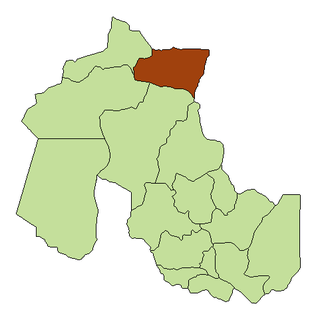
La Quiaca is a small city in the north of the province of Jujuy, Argentina, on the southern bank of the La Quiaca River, opposite the town of Villazón, Bolivia. It lies at the end of National Route 9, 289 km (180 mi) from San Salvador de Jujuy, and at an altitude of 3,442 m (11,293 ft) above mean sea level.

El Calafate is a city in Patagonia, Argentina. It is situated on the southern border of Lake Argentino, in the southwest part of the Santa Cruz Province, about 320 km Northwest of Río Gallegos. The name of the city is derived from a little bush with yellow flowers and dark blue berries that is very common in Patagonia: the calafate ; the word comes from the word "calafate", which is Spanish for "caulk".

San Antonio Oeste is a port city in the Argentine province of Río Negro, and head of the department of San Antonio.
Gobernador Gregores is a town in Santa Cruz Province, Argentina, formerly known as Cañadón León. Ramón Outerello, one of the leaders of the massive strike known as Patagonia rebelde was executed there by a firing squad of the Argentine Army in November 1921.

Paso de Indios is a town in Chubut Province, Argentina. It is the head town of the Paso de Indios Department.

The climate of Argentina is a vastly complex subject, as the vast size of the country and wide variation in altitude make for a wide range of climate types. Summers are the warmest and wettest season in most of the country except in most of Patagonia where it is the driest season. Winters are normally mild in the north, cool in the center and cold in the southern parts experiencing frequent frost and snow. Because southern parts of the country are moderated by the surrounding oceans, the cold is less intense and prolonged than areas at similar latitudes in the northern hemisphere. Spring and autumn are transition seasons that generally feature mild weather.

Las Lomitas is a city in northern Argentina. It is located in Formosa Province. It is located in the Patiño Department in the center of Formosa Province. It has a population of 12,399 inhabitants as of the 2010 census [INDEC]. This represented a 20% increase in the population compared to the 2001 census [INDEC] which only had 10,354 inhabitants.
Gobernador Costa (Chubut) is a village and municipality in Chubut Province in southern Argentina.
Mina La Casualidad is a village and rural municipality in Salta Province in northwestern Argentina.

Due to its vast size and range of altitudes, Argentina possesses a wide variety of climatic regions, ranging from the hot subtropical region in the north to the cold subantarctic in the far south. Lying between those is the Pampas region, featuring a mild and humid climate. Many regions have different, often contrasting, microclimates. In general, Argentina has four main climate types: warm, moderate, arid, and cold in which the relief features, and the latitudinal extent of the country, determine the different varieties within the main climate types.









